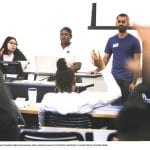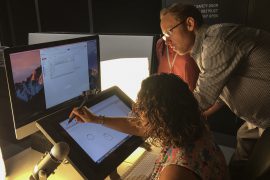The month’s highlights on higher education from across the web
1.‘Is It Ever OK to Lecture?’

Is it ever ok to lecture? Good question. Recent years have seen the value of lecturing called into question, with proponents on either side of the debate either calling for the death of the lecture or defending it as a relevant and robust method of teaching. In this article from The Chronicle, David Gooblar argues yes, it is ok to lecture, but it all depends on how you do it. Given the nuances of the use of lectures, Gooblar writes that it’s the capacity to modify components of how you lecture, to fit different purposes, that keeps it so powerful. Telling information can be a great method when the task is to inform students of specific information. However, this is not so good when trying to teach “complex ideas, conceptual knowledge, or difficult skills”, where active learning techniques are much more useful.
2.How to Teach a Good First Day of Class

The first day of class is crucial both for your students and for you, so as you start thinking about all that lies ahead, also take a moment to consider what you have planned for the very first class. This can set the tone for the whole semester and, with a little forethought, can be much more than a summary of the important aspects of the unit outline. This article from The Chronicle of Higher Education has some great strategies to help you make the first day of class as effective as possible. Check out examples of how you can create engaging and meaningful experiences for your students from day 1 – or in some cases, before you even walk into the room.
3.Your Students Learn by Doing, Not by Listening
 For our students to gain more than specific information — to gain understanding, rather than just knowledge of a set of facts — we need to design learning experiences where they gain that understanding for themselves. In other words, they need to learn actively. Over on The Chronicle, we hear again from David Gooblar on why this active approach is so important. David says that successful teaching isn’t about simply persuading students to see things your way; that to ‘teach’ is not about putting new knowledge into our students’ heads. He argues that often the only way to change a students’ mind or for successful learning to occur is when students actually experience something themselves, as opposed to just being told. This is one of the reasons why active-learning strategies work so well. To create successful learning environments for students, we need to focus not on what we saying to our students, but rather on what our students are doing.
For our students to gain more than specific information — to gain understanding, rather than just knowledge of a set of facts — we need to design learning experiences where they gain that understanding for themselves. In other words, they need to learn actively. Over on The Chronicle, we hear again from David Gooblar on why this active approach is so important. David says that successful teaching isn’t about simply persuading students to see things your way; that to ‘teach’ is not about putting new knowledge into our students’ heads. He argues that often the only way to change a students’ mind or for successful learning to occur is when students actually experience something themselves, as opposed to just being told. This is one of the reasons why active-learning strategies work so well. To create successful learning environments for students, we need to focus not on what we saying to our students, but rather on what our students are doing.
4.When You Communicate With Students, Tone Matters

Creating a supportive learning environment can have a strong influence on student motivation and success. This article walks us through how we can help to positively influence the climate of our classrooms to make them welcoming and inclusive for all students. There are things we can continually do as teachers to help students feel supported: we can strive to be reassuring, approachable, and encouraging – both in person and online; we can encourage the development of peer relationships in and out of the classroom; and we can treat students equitably and recognise, and correct, our own microinequities.
5.Teaching Resolutions for the New Year [*from the archive]

It’s the new [teaching] year. Do you have a new year’s teaching resolution for yet? If you don’t, James Lang has one for you: experiment more. Why? As a time-poor academic, it’s easy to fall back into autopilot: same curriculum, same assessment, same attitude to your students. Sometimes, a small change can be the nudge you need to help you stop and change your approach. As Lang explains, he experimented by starting to use a new piece of technology in his teaching each semester. While the new technology approach might not be your cup of tea, the overall idea holds: try something new! Mixing up your teaching practices, even just a little bit, can open you up to new ideas. Be inspired with this short piece on how it can be done. You never know where is might lead.
6.Is Anybody Out There Reading the Syllabus: To Find Out, Some Professors Bury Hidden Gems [*from the archive]

It’s the age old question – how do we get students to read the unit outline? While you might feel like you are butting your head against a wall, there could be some small things you can do to help increase unit outline readership. This “one from the archive” (but no less relevant today) highlights a few novel techniques academics in the USA have used to increase the readership of and, even better, engagement with, their unit outlines. Not all will work (or even be possible), but you might find something that speaks to your situation.





